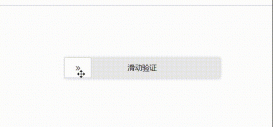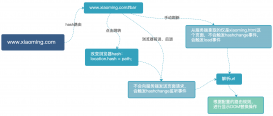單頁面應用特征
「假設:」 在一個 web 頁面中,有1個按鈕,點擊可跳轉到站內其他頁面。
「多頁面應用:」 點擊按鈕,會從新加載一個html資源,刷新整個頁面;
「單頁面應用:」 點擊按鈕,沒有新的html請求,只發生局部刷新,能營造出一種接近原生的體驗,如絲般順滑。
SPA 單頁面應用為什么可以幾乎無刷新呢?因為它的SP——single-page。在第一次進入應用時,即返回了唯一的html頁面和它的公共靜態資源,后續的所謂“跳轉”,都不再從服務端拿html文件,只是DOM的替換操作,是模(jia)擬(zhuang)的。
那么js又是怎么捕捉到組件切換的時機,并且無刷新變更瀏覽器url呢?靠hash和HTML5History。
hash 路由
特征
- 類似www.xiaoming.html#bar 就是哈希路由,當 # 后面的哈希值發生變化時,不會向服務器請求數據,可以通過 hashchange 事件來監聽到 URL 的變化,從而進行DOM操作來模擬頁面跳轉
- 不需要服務端配合
- 對 SEO 不友好
原理

hash
HTML5History 路由
特征
- History 模式是 HTML5 新推出的功能,比之 hash 路由的方式直觀,長成類似這個樣子www.xiaoming.html/bar ,模擬頁面跳轉是通過 history.pushState(state, title, url) 來更新瀏覽器路由,路由變化時監聽 popstate 事件來操作DOM
- 需要后端配合,進行重定向
- 對 SEO 相對友好
原理

HTML5History
vue-router 源碼解讀
以 Vue 的路由vue-router為例,我們一起來擼一把它的源碼。
Tips:因為,本篇的重點在于講解單頁面路由的兩種模式,所以,下面只列舉了一些關鍵代碼,主要講解:
- 注冊插件
- VueRouter的構造函數,區分路由模式
- 全局注冊組件
- hash / HTML5History模式的 push 和監聽方法
- transitionTo 方法
注冊插件
首先,作為一個插件,要有暴露一個install方法的自覺,給Vue爸爸去 use。
源碼的install.js文件中,定義了注冊安裝插件的方法install,給每個組件的鉤子函數混入方法,并在beforeCreate鉤子執行時初始化路由:
|
1
2
3
4
5
6
7
8
9
10
11
12
13
14
15
|
Vue.mixin({ beforeCreate () { if (isDef(this.$options.router)) { this._routerRoot = this this._router = this.$options.router this._router.init(this) Vue.util.defineReactive(this, '_route', this._router.history.current) } else { this._routerRoot = (this.$parent && this.$parent._routerRoot) || this } registerInstance(this, this) }, // 全文中以...來表示省略的方法 ...}); |
區分mode
然后,我們從index.js找到整個插件的基類 VueRouter,不難看出,它是在constructor中,根據不同mode 采用不同路由實例的。
|
1
2
3
4
5
6
7
8
9
10
11
12
13
14
15
16
17
18
19
20
21
22
23
24
25
26
27
28
29
30
31
32
33
|
...import {install} from './install';import {HashHistory} from './history/hash';import {HTML5History} from './history/html5';...export default class VueRouter { static install: () => void; constructor (options: RouterOptions = {}) { if (this.fallback) { mode = 'hash' } if (!inBrowser) { mode = 'abstract' } this.mode = mode switch (mode) { case 'history': this.history = new HTML5History(this, options.base) break case 'hash': this.history = new HashHistory(this, options.base, this.fallback) break case 'abstract': this.history = new AbstractHistory(this, options.base) break default: if (process.env.NODE_ENV !== 'production') { assert(false, `invalid mode: ${mode}`) } } }} |
全局注冊router-link組件
這個時候,我們也許會問:使用 vue-router 時, 常見的<router-link/>、 <router-view/>又是在哪里引入的呢?
回到install.js文件,它引入并全局注冊了 router-view、router-link組件:
|
1
2
3
4
5
|
import View from './components/view';import Link from './components/link';...Vue.component('RouterView', View);Vue.component('RouterLink', Link); |
在 ./components/link.js 中,<router-link/>組件上默認綁定了click事件,點擊觸發handler方法進行相應的路由操作。
|
1
2
3
4
5
6
7
8
9
|
const handler = e => { if (guardEvent(e)) { if (this.replace) { router.replace(location, noop) } else { router.push(location, noop) } }}; |
就像最開始提到的,VueRouter構造函數中對不同mode初始化了不同模式的 History 實例,因而router.replace、router.push的方式也不盡相同。接下來,我們分別扒拉下這兩個模式的源碼。
hash模式
history/hash.js 文件中,定義了HashHistory 類,這貨繼承自 history/base.js 的 History 基類。
它的prototype上定義了push方法:在支持 HTML5History 模式的瀏覽器環境中(supportsPushState為 true),調用history.pushState來改變瀏覽器地址;其他瀏覽器環境中,則會直接用location.hash = path 來替換成新的 hash 地址。
其實,最開始讀到這里是有些疑問的,既然已經是 hash 模式為何還要判斷supportsPushState?原來,是為了支持scrollBehavior,history.pushState可以傳參key過去,這樣每個url歷史都有一個key,用 key 保存了每個路由的位置信息。
同時,原型上綁定的setupListeners 方法,負責監聽 hash 變更的時機:在支持 HTML5History 模式的瀏覽器環境中,監聽popstate事件;而其他瀏覽器中,則監聽hashchange。監聽到變化后,觸發handleRoutingEvent 方法,調用父類的transitionTo跳轉邏輯,進行 DOM 的替換操作。
|
1
2
3
4
5
6
7
8
9
10
11
12
13
14
15
16
17
18
19
20
21
22
23
24
25
26
27
28
29
30
31
32
33
34
35
36
37
38
39
40
41
42
43
44
45
46
47
48
49
50
51
52
53
54
55
56
57
58
59
60
61
62
63
64
65
66
67
68
69
70
71
72
73
74
75
76
77
78
79
|
import { pushState, replaceState, supportsPushState } from '../util/push-state'...export class HashHistory extends History { setupListeners () { ... const handleRoutingEvent = () => { const current = this.current if (!ensureSlash()) { return } // transitionTo調用的父類History下的跳轉方法,跳轉后路徑會進行hash化 this.transitionTo(getHash(), route => { if (supportsScroll) { handleScroll(this.router, route, current, true) } if (!supportsPushState) { replaceHash(route.fullPath) } }) } const eventType = supportsPushState ? 'popstate' : 'hashchange' window.addEventListener( eventType, handleRoutingEvent ) this.listeners.push(() => { window.removeEventListener(eventType, handleRoutingEvent) }) } push (location: RawLocation, onComplete?: Function, onAbort?: Function) { const { current: fromRoute } = this this.transitionTo( location, route => { pushHash(route.fullPath) handleScroll(this.router, route, fromRoute, false) onComplete && onComplete(route) }, onAbort ) }}...// 處理傳入path成hash形式的URLfunction getUrl (path) { const href = window.location.href const i = href.indexOf('#') const base = i >= 0 ? href.slice(0, i) : href return `${base}#${path}`}...// 替換hashfunction pushHash (path) { if (supportsPushState) { pushState(getUrl(path)) } else { window.location.hash = path }}// util/push-state.js文件中的方法export const supportsPushState = inBrowser && (function () { const ua = window.navigator.userAgent if ( (ua.indexOf('Android 2.') !== -1 || ua.indexOf('Android 4.0') !== -1) && ua.indexOf('Mobile Safari') !== -1 && ua.indexOf('Chrome') === -1 && ua.indexOf('Windows Phone') === -1 ) { return false } return window.history && typeof window.history.pushState === 'function' })() |
HTML5History模式
類似的,HTML5History 類定義在 history/html5.js 中。
定義push原型方法,調用history.pusheState修改瀏覽器的路徑。
與此同時,原型setupListeners 方法對popstate進行了事件監聽,適時做 DOM 替換。
|
1
2
3
4
5
6
7
8
9
10
11
12
13
14
15
16
17
18
19
20
21
22
23
24
25
26
27
28
29
30
31
32
33
34
35
36
37
38
39
40
41
42
43
44
45
46
47
48
49
50
51
52
|
import {pushState, replaceState, supportsPushState} from '../util/push-state';...export class HTML5History extends History { setupListeners () { const handleRoutingEvent = () => { const current = this.current; const location = getLocation(this.base); if (this.current === START && location === this._startLocation) { return } this.transitionTo(location, route => { if (supportsScroll) { handleScroll(router, route, current, true) } }) } window.addEventListener('popstate', handleRoutingEvent) this.listeners.push(() => { window.removeEventListener('popstate', handleRoutingEvent) }) } push (location: RawLocation, onComplete?: Function, onAbort?: Function) { const { current: fromRoute } = this this.transitionTo(location, route => { pushState(cleanPath(this.base + route.fullPath)) handleScroll(this.router, route, fromRoute, false) onComplete && onComplete(route) }, onAbort) }}...// util/push-state.js文件中的方法export function pushState (url?: string, replace?: boolean) { saveScrollPosition() const history = window.history try { if (replace) { const stateCopy = extend({}, history.state) stateCopy.key = getStateKey() history.replaceState(stateCopy, '', url) } else { history.pushState({ key: setStateKey(genStateKey()) }, '', url) } } catch (e) { window.location[replace ? 'replace' : 'assign'](url) }} |
transitionTo 處理路由變更邏輯
上面提到的兩種路由模式,都在監聽時觸發了this.transitionTo,這到底是個啥呢?它其實是定義在 history/base.js 基類上的原型方法,用來處理路由的變更邏輯。
先通過const route = this.router.match(location, this.current)對傳入的值與當前值進行對比,返回相應的路由對象;接著判斷新路由是否與當前路由相同,相同的話直接返回;不相同,則在this.confirmTransition中執行回調更新路由對象,并對視圖相關DOM進行替換操作。
|
1
2
3
4
5
6
7
8
9
10
11
12
13
14
15
16
17
18
19
20
21
22
23
24
25
26
27
28
29
30
31
32
33
34
35
36
37
38
39
40
41
42
43
44
45
46
47
48
|
export class History { ... transitionTo ( location: RawLocation, onComplete?: Function, onAbort?: Function ) { const route = this.router.match(location, this.current) this.confirmTransition( route, () => { const prev = this.current this.updateRoute(route) onComplete && onComplete(route) this.ensureURL() this.router.afterHooks.forEach(hook => { hook && hook(route, prev) }) if (!this.ready) { this.ready = true this.readyCbs.forEach(cb => { cb(route) }) } }, err => { if (onAbort) { onAbort(err) } if (err && !this.ready) { this.ready = true // https://github.com/vuejs/vue-router/issues/3225 if (!isRouterError(err, NavigationFailureType.redirected)) { this.readyErrorCbs.forEach(cb => { cb(err) }) } else { this.readyCbs.forEach(cb => { cb(route) }) } } } ) } ...} |
最后
好啦,以上就是單頁面路由的一些小知識,希望我們能一起從入門到永不放棄~~
到此這篇關于10分鐘徹底搞懂微信小程序單頁面應用路由的文章就介紹到這了,更多相關小程序單頁面應用路由內容請搜索服務器之家以前的文章或繼續瀏覽下面的相關文章希望大家以后多多支持服務器之家!
原文鏈接:https://juejin.cn/post/6855129006552514568
















